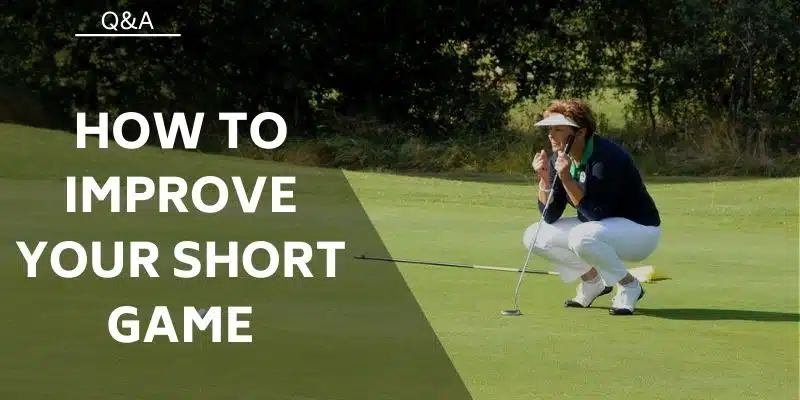Stroke play and match play are two of the three most popular formats. I often play both in casual and tournament rounds, and there is a strategy for each. If you don’t understand the strategy, you may be losing to your buddies more than you’d like.
In this post, I hone in on the difference between match play and stroke play, highlighting the scoring, strategy, and handicap structure for each format.
At the conclusion of this guide, you will know exactly how to optimize your round for a match play or stroke play event. With this knowledge, you can educate your playing partners and employ it in your round to avoid sticking to the same boring Stableford format.
Stroke Play vs Match Play: What Is The Difference?
Stroke play requires golfers to count every stroke from the first tee to the 18th green. The player with the fewest strokes wins the round. The player or team with the lowest score wins the hole in match play. The match continues until the 18th hole or when one player is mathematically unable to tie or win from their position.
What Is The Difference Between Stroke Play and Match Play?
Stroke and match play differ in how you keep score, declare the winner, or finish a hole. Stroke play requires you to count every shot you hit from the first tee until your ball drops into the 18th cup. The player carding the fewest strokes then wins the round.
Match play is contested against a single opponent or as a fourball. The player with the lowest score on a hole is awarded that hole. The contest is over when the losing player does not have enough holes remaining to reverse fortunes and draw or win the match.
In the below sections, I detail the differences between the structure in a match vs stroke play round of golf.
Read More: Best Ball Golf Format Explained
Scoring Difference Between Stroke Play And Match Play
Stroke Play
The scoring differs in golf match play vs stroke play, with the latter most employed in PGA Tour events. In stroke play, you count every shot you hit during your round, whether you score a birdie 2 on a par 3 or a 10 on a par 3. I have been on the receiving end of both of those scores.
Tally up your strokes at the end of the round to receive your gross score before subtracting your handicap from the gross to receive your net score. The golfer with the lowest net score is declared the winner.
Thanks to the handicap system, high, mid, and low handicappers can compete against each other as equals. Play to your handicap and focus on returning a low net.
Match Play
The aim of match play is to win more holes than your opponent. If it reaches the point where your opponent cannot draw or win the match, you are declared the victor, and you can walk back to the clubhouse.
Match play is my favorite format because a terrible hole is not severely punished. In match play, if I carded a 7 on a par 4 and my opponent a 3, I would only go 1 down. Conversely, if the same happened in stroke play, my opponent would be 1 under par, and I would be 3 over par. Climbing back from 4 shots is not impossible, but it is challenging.
Handicaps play a role in match play as well. If I am an 18 handicap and play against a 9 handicap, I stroke on 9 more holes, giving me an advantage. Therefore, if my opponent and I bogey a par 4 stroke 10 hole, I win the hole because my gross bogey is a net par thanks to my handicap.
Strategy Difference Of Stroke Play vs Match Play In Golf
Stroke Play
A stroke play tournament sees you compete against the entire field. This calls for a complete focus on your strengths, weaknesses, and abilities of your golf game. Astute decision-making is essential when every stroke counts, so I suggest playing safe and intelligently to return a respectable score.
Think about laying up instead of hitting over hazards on long shots, and leave the driver in the bag on shorter par 4s. Keep out of trouble and do everything you can to card a low round. You cannot control how others play, so do not focus on them.
Match Play
Naturally, I also recommend playing to your strengths in match play, but you need to factor in your opponent’s lie. Learn to improvise and adapt to the situation. For example, when I was a college golfer, I played one round where I only took my driver out of the bag once.
It was one-on-one match play on a coastal course with gale-force winds carrying the ball all over. My opponent had the honors on the first hole, grabbed his driver, and hit his first shot out of bounds. Despite being a par 5, I decided to take my 2-iron, knock it low, and keep it in play.
My opponent reloaded and hit his second drive out of bounds, teed up a third, and finally kept it in play. All I needed to do that day was focus on staying straight, and I could win. This contradicted my initial plan to use the woods for distance. The scorecard was not pretty for either of us, but I ended up winning 5 and 4.
Round Duration
A stroke play round is typically played over 18 holes, and you do not stop until your ball is sitting at the bottom of the cup on the 18th. However, the round can finish before you reach the final hole in match play.
As I explained earlier about my experience where I was 5 up with only 4 holes to play, it was mathematically impossible for my opponent to tie or win the match from that position. I was declared the winner on the 14th green, and we returned to the clubhouse.
Rules Of Match Play vs Stroke Play
The rules of match play vs stroke play differ slightly regarding the implementation of handicaps, scoring, duration, and how the winner is decided.
Handicaps
In stroke play, the use of handicaps is straightforward. Calculate your total strokes for the round to get your gross score, then subtract your handicap from the gross to determine your net score. The player with the lowest net score is the winner.
Although still applicable, the implementation of handicaps differs slightly and requires work on a hole-by-hole basis. Work out how many holes you stroke compared to your opponent, and remember those holes for later in the round.
If you are an 18 handicap, it means you stroke on every hole on the golf course. Therefore, a gross bogey is a net par. Conversely, if you play against a scratch golfer without holes, the stroke system plays in your favor.
If you and your opponent card a gross bogey, you will win the hole because you stroke. A gross bogey is a net par for you, which beats your peer’s net bogey score.
Scoring
Every shot counts in stroke play. Whether you card a 2 or a 10, it must be written in the scorecard. After you complete 18 holes, you tally up your total strokes for the round, determining your gross score. Then, you subtract your handicap from the gross score to get your net score.
For example, I am a 12 handicap. If I shoot 84 gross on a par 72, my net score is 72, which is a decent day out. However, if I card a 92 gross, my net is 80, which is 8 over par, a terrible round of golf.
In match play, if you do not feel you can draw or win a hole, you can concede it to your opponent and move on to the next hole. Match play is scored by holes rather than strokes, which gives players a chance to mount a comeback after a difficult start.
Winner
The winner in stroke play and match play events is determined differently. For example, in a stroke play event, we wait until the entire field has signed and returned their cards before checking which player recorded the lowest score.
On the contrary, the winner of a match play event is determined immediately on the course. That is because you are only competing against one individual or team rather than a complete field of players.
Are Stroke Play vs Match Play In Golf Done At The Same Time?
Although the USGA discourages intertwining stroke play vs match play affairs in a tournament setting, it can be done. In my case, my high school and college coaches wanted team members to keep the stroke play score during our match play.
Just because I won a match did not mean I played well, as my coaches wanted to know every detail of my round.
FAQ
Is The Masters Stroke Play Or Match Play?
The Masters is a 72-hole stroke play tournament played over 4 rounds. The golfer with the lowest score after the fourth round of competition receives the coveted green jacket.
Is Match Play Or Stroke Play Better?
Match play is better than stroke play for the average golfer during casual rounds. It creates an element of competition and prevents one poor hole from ruining your entire round. However, serious golfers are advised to employ stroke play to improve their performance under pressure and prepare for upcoming tournaments.
Final Thoughts
My guide analyzing the difference between match play and stroke play reveals that the formats differ in scoring, strategy, and round duration. I find match play is ideal for all golfers looking to add a competitive edge to every round and cushion themselves from the scorecard punishment of one nasty hole.
Although match play is my favored format, and I would highly recommend it, there is a place for stroke play. Counting every stroke teaches you to think wisely about club selection, alignment, and shot shape. It makes you a better golfer by teaching you how to recover and overcome adversity on the golf course.
Matt has played golf since he was 4 years old and has written over 150 articles at GolfSpan since 2021. Matt specializes in product reviews using his postgraduate degree in Sports Marketing from Johan Cruyff Institute. Matt has a handicap index of 10.8 and currently plays weekly at Pilar Golf Course near his home in Buenos Aires, Argentina. He also loves his Callaway Odyssey Exo Rossie putter and likes a pepper steak pie with curry gravy at the turn. You can connect with him on LinkedIn.
- Best score: 70
- Favorite club: Callaway Odyssey Exo Rossie
- Favorite ball: Srixon Q-Star Tour
- Favorite food at the turn: Pepper steak pie with curry gravy









